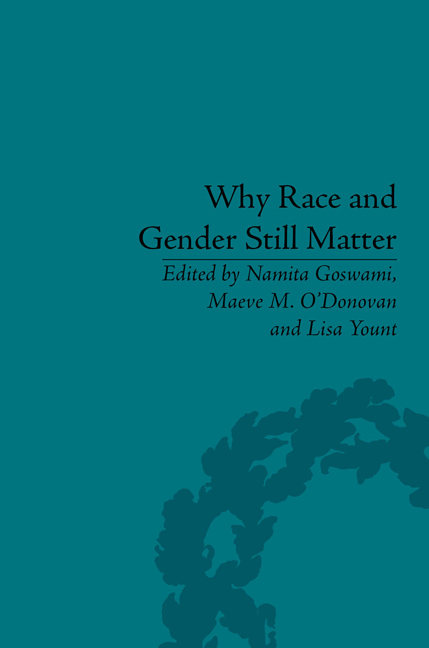Book contents
- Frontmatter
- CONTENTS
- Dedication
- Acknowledgements
- List of Contributors
- Introduction to Why Race and Gender Still Matter: An Intersectional Analysis
- Part I Defining Intersectionality
- Part II Doing Intersectionality
- 6 Continental Feminist Philosophy Meets Intersectionality: Rosi Braidotti's Work
- 7 Purposeful Nonsense, Intersectionality and the Mission to Save Black Babies
- 8 Transitional Subjects: Gender, Race and the Biopolitics of the Real
- 9 Caster Semenya: Reasoning Up Front with Race
- 10 Philosophical Happiness and the Relational Production of Philosophical Space
- 11 Theory Can Heal: Constructing an Ethos of Intervention
- Notes
- Index
9 - Caster Semenya: Reasoning Up Front with Race
from Part II - Doing Intersectionality
- Frontmatter
- CONTENTS
- Dedication
- Acknowledgements
- List of Contributors
- Introduction to Why Race and Gender Still Matter: An Intersectional Analysis
- Part I Defining Intersectionality
- Part II Doing Intersectionality
- 6 Continental Feminist Philosophy Meets Intersectionality: Rosi Braidotti's Work
- 7 Purposeful Nonsense, Intersectionality and the Mission to Save Black Babies
- 8 Transitional Subjects: Gender, Race and the Biopolitics of the Real
- 9 Caster Semenya: Reasoning Up Front with Race
- 10 Philosophical Happiness and the Relational Production of Philosophical Space
- 11 Theory Can Heal: Constructing an Ethos of Intervention
- Notes
- Index
Summary
Using race as an essential component in the construction and understanding of sex-gendered identities seems, in some quarters, to challenge theoretical practice. Though other theorists may not, I speak of sex-gender identity as opposed to sex and gender identity. I do so to indicate that understandings of sex and understandings of gender may mutually construct an identity. Following this line of thought, a race-sex-gender identity obtains when understandings of race, sex and gender mutually construct an identity.
Theorists such as Evelyn Brooks Higgenbotham and Sherene Razack have inveighed against the erasure of race in feminist analyses of sex and gender. Razack is adamant that her insistence on race playing an essential role in our theorizing about interlocking oppressions has not so much to do with inclusivity as it has to do with constructing views that are up to the task of representing and elucidating the socio-ontological realities we take ourselves to be addressing. The erasure of race or its relegation to an ad hoc role is notable in some of the literature devoted to Caster Semenya, the South African runner subjected to a sex verification test after winning the 800-metre race at the 2009 World Track and Field Championships in Berlin. The auxiliary use of race in theorizing about Semenya has resulted – as Higgenbotham and Razack could have predicted – in an understanding of Semenya's sex-gender identity that is erroneous and in adequate.
- Type
- Chapter
- Information
- Why Race and Gender Still MatterAn Intersectional Approach, pp. 133 - 156Publisher: Pickering & ChattoFirst published in: 2014



